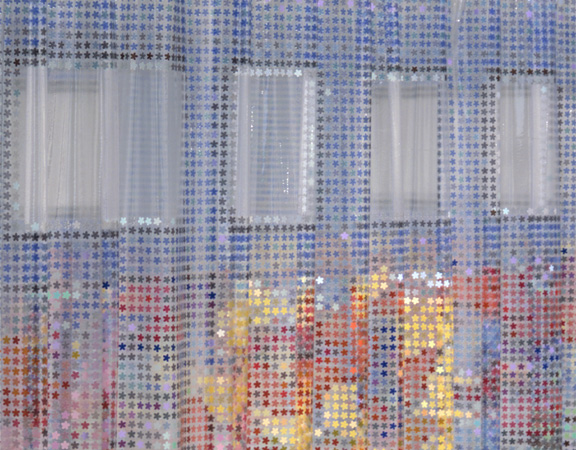Rocky Mountain News
January 25, 2003
"High-tech
impact comes through unplugged "
by Mary Voelz Chandler

A detail from Devorah Sperber's 2001 VW Bus: Shower Power, an
installation that uses clear vinyl, Chartpak colored film,
and an aluminum frame to demonstrate digital agility
Here's to academic art galleries, which can venture into unknown territory more comfortably than commercial operations, yet (usually) muster more financial resources than alternative spaces.
Like the Victoria H. Myhren Gallery at the University of Denver. It began the season with a bang (dimensional paintings by Ronald Davis) and continues with a thoughtful exhibition that examines the impact of technology on art without one computer in sight.
So in "Duality/Autonomy," there's nothing to plug in and nothing to break down. Instead, guest curator Jeffrey Keith has called upon one artist who uses traditional materials to impart information about science, and another artist who uses high-tech processes to turn pretty basic stuff into objects of art. Though the two may come from a point at different ends of the tech-spectrum, Keith notes, each is examining how art and science relate.
He is a savvy enough painter and instructor of color theory to know that the point would be moot if the art weren't any good. In the case of paintings by Clark Richert and fabricated objects by Devorah Sperber, the art is good.
It helps that the gallery is a long, narrow shape that allows two different types of work to relate yet keep their identity, thus the duality/autonomy title. Too, color is key here, and both artists come to it in different approaches.
Sperber, who moved to New York in the early 1990s from Denver (last seen here: sculpture), is making a name for her use of digital images to create patterns fleshed out with simple materials. In "Duality/Autonomy," she uses bright-topped map tacks on clear vinyl to create wall-mounted works that seem to vibrate. These include two deftly constructed bikini sets, but more convincingly a quartet of bandanas. Or at least they look like bandanas, since two are 3-D, draped as if fabric, and two are made in a flat plane, with implied folds. The patterns and rhythms make your eyes move.
An even more massive exercise in equating a point into the equivalent of a pixel is her approximation of a large vehicle - the 80-by-63-by-136-inch VW Bus: Shower Power - through the use of clear shower curtains hung on aluminum tubing and decorated with thousands of flowers made of color film. Fisheye mirrors on walls around the Bus return distorted reflections that make your eyes move even more.
The other work on view, a suite of four new paintings by Richert, will make your brain move.
Richert, a veteran painter who lives in Denver and heads the painting department at the Rocky Mountain College of Art and Design, is known for paintings that bring formulas to life in geometric compositions. That is evident in the two older works that augment the show, LA-AC Periods and H-XE Periods, both references to periodic tables and both seen in a rare 2001 solo show of his work at Rule Gallery.
For the Myhren exhibition, though, Richert has moved into another dimension. The geometry is still there, to be sure, and the drips and marks that show a human hand did play a role here. But he has expanded and loosened his lines, showing open, swirling images that refer to theories of motion and activity.
The Turbulence Machine, for example, refers to sculptor Kenneth Snelson's studies in imaging atoms, and inserts them into a latticework structure (the painting was called Snelsonian Motion. Waves, particles, motion and the role of the truncated octahedron flow through Richert's new paintings, which also appeal on the level of lyrical, free-flowing movement.
With work that aims for the intellectual and the practical at one time, "Duality/Autonomy" turns light and matter into optical reality. The illusion is only in your head.
Duality/Autonomy
• What: Wall-hung work and an installation by Devorah Sperber and paintings
by Clark Richert
• Where: Victoria H. Myhren Gallery, Shwayder Art Building, 2100 E. Asbury
Ave., University of Denver
• When: Through Feb. 21
• Information: (303) 871-2846
Mary Voelz Chandler is the art and architecture critic.
Chandlerm@RockyMountainNews.com or (303) 892-2677.